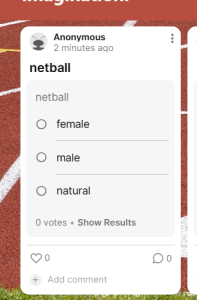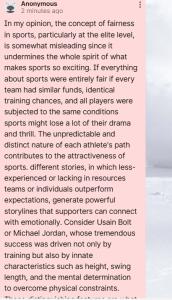2
Section One: The Fundamentals
A) History and Context
Exercise 1: Notebook Prompt
| The Injustice of ‘Nude Parades’ – Before the advent of scientific testing, female athletes were subjected to degrading visual inspections to prove their sex. This humiliating and unjust practice persisted into the 1960s, prompting a strong sense of empathy for the athletes who tolerated it.
Unreliability of Chromosome Testing – The introduction of genetic testing in 1968 led to the unfair disqualification of intersex athletes. These athletes, who might have XY chromosomes but developed as women, were unfairly punished, emphasizing the injustice of the situation. Double Standards in Gender Testing – Despite severe doping regulations, no male athlete has ever been required to prove his gender to compete. This contrast in treatment underscores the inequality in sports gender testing. Sex Testing Policies Keep Changing – From physical inspections to chromosome tests to testosterone limits; sports organizations have repeatedly shifted their criteria for “womanhood,” often in response to backlash.
|
B) Timeline of History
Exercise 2: Notebook Prompt
What other significant case/milestone would you add to this timeline? Note it in your notebook along with a brief (one or two sentences) explanation of why you feel it is important.
| In 1973, Billie Jean King defeated Bobby Riggs in the “Battle of the Sexes,” challenging gender stereotypes about women’s athletic abilities and marking a memorable moment for gender equality in sports. In 2015, the Athlete Biological Passport system was introduced by WADA to monitor athletes’ biological markers, including testosterone, aiming to improve anti-doping efforts. These events highlight the intersection of gender, sport, and fairness, setting the stage for ongoing debates about sex and gender verification in competitive athletics.
|
C) Gender coding in Sports
Exercise 3: Notebook Prompt
Has the gendering of sport ever been a constraint on your involvement? How?
Or, if not, why do you think this is?
| Gender has never been a constrain in my involvement with sports since in school, they always put us girls and boys, and when you were trying out for a sport, it was always fair without gender discrimination,n and I think we are more evolved and understanding with the years and that discrimination between genders is not as big right now comparing to past years
|
D) How is sport gendered in the popular imagination?
Exercise 4: Padlet/Notebook Prompt
While most sports are in fact unisex, gender coding remains pervasive, particularly at the professional level, although with a foundation established in youth competition. Participate in the poll below to share your views on how popular sports are gendered in the popular imagination. Also feel welcome to add or suggest sports that you feel strongly conform to the gender binary!
After you contribute to the padlet prompt, record your response in your notebook AND briefly discuss in two or three sentences how these responses and the polling figures in general confirm or contradict your assumptions about gender-coding and sports. Did anything surprise you?

I haven’t found anything surprising since most sports are unisex now
|
Section Two: Breaking it down
A) Title IX
Exercise 5: Notebook Prompt
In a longer version of the interview excerpted in the video above, Leah Thomas states “Trans women competing in women’s sports does not threaten women’s sports as a whole because trans women are a very small minority of all athletes and the NCAA rules around trans women competing in women’s sports have been around for 10+ years and we haven’t seen any massive wave of trans women dominating”?
Do you agree with this statement? See also the image above suggesting that the issue may be overblown by politicians and influencers who don’t actually care that much about women’s sports.
Please share any thoughts you have in your Notebook by clicking on the audio button above or writing a few sentences.
| In my opinion, I don’t believe trans women should be involved in women’s sports solely because they are trans. While I understand that sports should be inclusive, the physical advantages that trans women who transitioned after puberty might have can create an uneven playing field. Sports are built on fairness, and it’s important to ensure that cisgender women have equal opportunities to succeed and compete without feeling at a disadvantage. This issue goes beyond gender identity it’s about maintaining fair competition for all athletes. That being said, this issue is often overblown by politicians and influencers who don’t necessarily care about the fairness of women’s sports but are using it to push an agenda. The discussions around this topic often ignore the complexity of both inclusion and fairness, reducing it to a debate rather than a fine conversation about how to create a more equitable sporting environment.
|
B) Unfair Advantage?
Exercise 6: Notebook Prompt
What does the host and writer, Rose Eveleth, have to say on the issue of unfair advantage?
Can you think of other examples of unique biological or circumstantial advantages from which athletes have benefitted enormously that have nothing to do with gender?
| Rose Eveleth critiques the notion of an “unfair advantage” in sports, highlighting that many athletes benefit from unique biological and circumstantial factors unrelated to gender. For example, some athletes may have naturally higher red blood cell counts, which enhances endurance. Others may come from regions with specific environmental conditions that improve performance, such as high-altitude training. Moreover, certain body types, flexibility, and muscle composition can give athletes an advantage in their respective sports. These factors often go unquestioned, yet they can provide just as much of an edge as any gender-related advantage. Therefore, the issue of unfair advantage should be viewed in a broader context, considering the many variables that shape an athlete’s success. Instead of focusing solely on gender, it would be more enlightening to acknowledge the full range of biological, environmental, and circumstantial factors contributing to athletic achievement. This would promote a more inclusive and comprehensive conversation about fairness in sports.
|
Again, let’s turn to Katie Barnes who points out that we tend to forget amidst all the debate that “sports, by design, are not fair” (235), that “the reality of sports is that we accept unfairness all the time” (235).
Do you agree? Why? In your experience, how fair are sports? Feel welcome to add a video response in the padlet and provide an example if you’re willing. Make sure you include a screenshot of your response in your notebook.

In my opinion, the concept of fairness in sports, particularly at the elite level, is somewhat misleading since it undermines the whole spirit of what makes sports so exciting. If everything about sports were entirely fair if every team had similar funds, identical training chances, and all players were subjected to the same conditions sports might lose a lot of their drama and thrill. The unpredictable and distinct nature of each athlete’s path contributes to the attractiveness of sports. different stories, in which less-experienced or lacking in resources teams or individuals outperform expectations, generate powerful storylines that supporters can connect with emotionally. Consider Usain Bolt or Michael Jordan, whose tremendous success was driven not only by training but also by innate characteristics such as height, swing length, and the mental determination to overcome physical constraints. These distinguishing features are what set them apart. If every athlete had the same potential and resources, we’d miss out on the thrill of seeing greatness emerge from unique talents, peculiarities, and even the occasional error. The human narrative behind physical performance, with all its flaws and unexpected twists, is what keeps sports interesting. The “what ifs” and successes give supporters something to cheer for and dream about. Without those plots, the entire sports experience would be far less significant and entertaining.
|
B) The Paris Olympics
Optional Response:
What does Robins mean when she argues that:
“The aims of transvestigating an Olympic athlete are not, in any meaningful sense, anything to do with sports, or fairness, or even with women (cis women, at least) as a social category. Rather, they have everything to do with transness, and the public expression of transfemininity.
For my money this has never been about sport.
What it has always been is an excuse to publicly relitigate the existence of trans women.”
Make a note in your Notebook.
| Robins argues that the intense hardels of trans athletes in the Olympics, particularly those who identify as trans women, is not truly about ensuring fairness in sports or protecting cisgender women. Instead, it serves as a platform to challenge the very existence of trans women and to reignite debates about their social legitimacy. According to Robins, the issue isn’t about competitive fairness in sports; it is a broader attempt to publicly question and invalidate trans identities. This reflects a continued societal discomfort with transgender people, particularly transfeminine individuals. And because they chose to transform doesn’t mean they are the same as biological women
|

